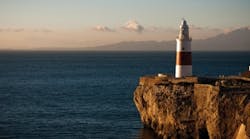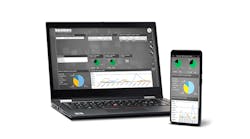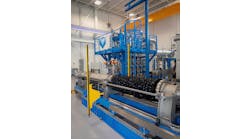Katherine Bonfante, Control's senior digital managing editor, also contributed to this story. Check her Google+ profile page.
Ceuta is one of those odd corners of the globe, a political anomaly cast up after centuries of political storm. Approximately 7-sq.mi. (18 sq km) territory on the north coast of Africa just west of Morocco, it lies about 12 mi (20 km) across the Strait of Gibraltar from Spain. Its strategic location has made it a contested bit of real estate all the way back to the Carthaginians. At various times, it has been under Roman, Byzantine, Moorish, Berber and Portuguese control. Since 1580, it has been claimed by Spain, and is now a Spanish "autonomous city."But Ceuta is no backwater. It is a very modern city with daily, high-speed ferry service to and from Cádiz in Spain. It is a free port, and oil, industry, retail and tourism drive its economy. Its population of some 78,000 gets its electricity from the Spanish electric power provider Endesa Generación.
Endesa generates 33% of Spain's electricity and has 25 plants spread over the Iberian Peninsula, plus five in the Balearic islands in the Mediterranean, nine in the Canary Islands, and two in Ceuta and Melilla, a similar city on the north coast of Africa near the Moroccan border. The power plant in Ceuta has an installed capacity of about 100 MW provided by nine diesel generators and a gas turbine.
See Also: Smart Calibration
Like most electricity providers today, Endesa's objective is to optimize its competitive position by producing electricity at a minimum cost, all while maximizing the availability of its equipment, ensuring the safety of its employees and respecting the natural environment. This is a tall order given that Endesa has electrical generating facilites spread out all over the Iberian peninsula, the southwestern Mediterannean and out in the Atlantic Ocean off the west coast of Africa.
Part of fulfilling this tall order means that keeping track of greenhouse gas emissions for regulatory and sustainability purposes is a big issue for Endesa. This effort is supported by Endress+Hauser's Promass flowmeters installed on its facilities' gensets. But installing flowmeters is only part of the solution. Those meters have to be calibrated, in Ceuta's case, every three years. And here's where things get a bit more complicated.
See Also: Save Money. Calibrate Less?
But regulatory and corporate demands aside, the calibration of the 11 flowmeters at the Ceuta facility present other challenges. All the flowmeters could not be removed at the same time because each genset has to be stopped when the flowmeter is removed, and Ceuta had only one backup flowmeter. Calibrating all of them at once would virtually shut down the facility. But doing them one at a time also presented problems. The process would drag out over nearly a year and incur extra costs.
Canosa says, "The original plan was to remove a flowmeter, replace it with a backup and send the flowmeter back to the manufacturer for calibration. But Ceuta has special tax and customs procedures, and the equipment must pass both procedures when being sent and when it is returned. This fact, coupled with the transporting and the calibration time, could take as long as a month for each one. With 11 flowmeters, the total calibration time could be up to 11 months."
See Also: Field Calibration of Magnetic Flowmeters: Case Study
Figure 2. A specialist from Endress+Hauser handles calibration complexities on-site, saving down time and shipping expenses.
At that point in 2010, Endesa began conversations with Endress+Hauser in Spain to find a better way. The solution was to use Endress+Hauser's on-site calibration service, one which the company says is unique in the industry. The service works this way. Once Endress+Hauser consults with a company to find out the scope of its needs and its plant availability, a time for the calibration is scheduled. The entire kit of necessary calibration equipment is packed in three flight cases, and a calibration specialist accompanies it to the facility, where the required calibration is carried out (Figures 2 and 3). At the end of the process, a Certificate of Calibration of unit under test (UUT) and the master meter's Swiss Calibration Services (SCS) certificate is delivered.At Ceuta, says Canosa: "First our maintenance people dismantled the flowmeters, and then cleaned and decontaminated them. Then the Endress+Hauser engineers connected the flowmeter to the testing computer, and checked and verified its calibration. If the calibration tests showed that the measurements were not as specified, the engineers recalibrated the system until the correct accuracy was achieved. The calibration takes between one and two hours. The entire process, including disassembly, assembly and calibration does not exceed more than three of four hours per flowmeter."
See Also: Market Intelligence Report: Flowmeters
Figure 3. The Endress+Hauser on-site calibration kit ships in three flight cases, bringing calibration directly to the sensors.
Canosa continues, "The advantages of on-site calibration are evident. In just four or five days, we had calibrated all the flowmeters. We also saved money by not having to pay for the transport and the special tax and customs procedures involved in shipping them back to the manufacturer."Endesa has not limited its use of Endress+Hauser's services to Ceuta. The Coriolis flowmeters in service in its diesel plants in Melilla, just up the coast from Ceuta, on the Balearics in the Mediterranean, and in the Canary Islands, about 62 mi (100 km) off the coast of western Africa, have also benefited from the on-site calibration service.
As for Ceuta, Canosa says the facility is already planning to use the service again next year when the next three-year calibration is required. "This time we will expand the on-site services to include the calibration of the temperature sensors within our flowmeters. This will increase the service
cost, but it will guarantee us more accurate temperature measurements.




